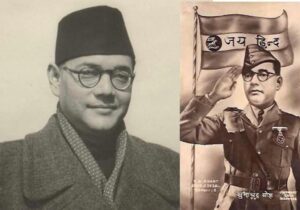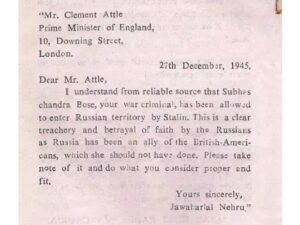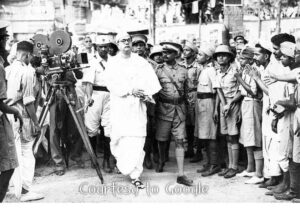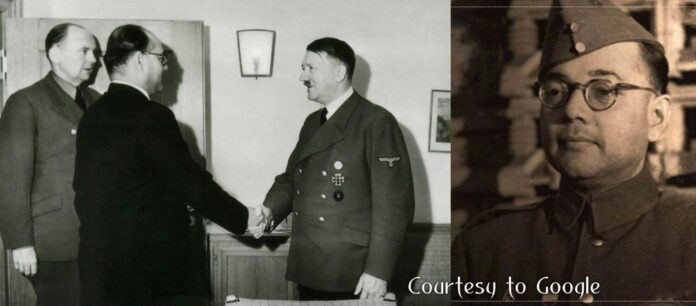Tribute to Netaji on his anniversary
Harigovind Vishwakarma
Pandit Jawahar Nehru is considered as the first Prime Minister of India. But we must also keep in mind the fact that Netaji Subhash Chandra Bose had established Arzi Hukumat-e-Azad Hind (the Provisional Government of Free India) and declared himself as the head on 21 October 1943. According to Jawaharlal Nehru University (JNU) historian Priyadarshan Mukherjee’s book ‘Netaji Subhas Chandra Bose and the Indian Liberation Movement in East Asia’, 11 countries including Germany, Japan, Italy, Nanking China, Thailand, Burma, Croatia and Philippines had recognized by that government. So, in this way, Subhas Chandra Bose, considered as Karna of the Indian politics, technically became the first Prime Minister of India. Most importantly, on 21 October in 2018, Prime Minister Narendra Modi also hoisted the tricolor from the Red Fort on the 75th anniversary of the Azad Hind.
The prime idea which motivated Netaji was to explore all possible means for achieving the cherished goal of India’s independence. It seems that he had adopted the concept that the ‘enemy’s enemy is your friend’ as he believes that freedom could be achieved by joining the enemies of the British. He was subsequently placed under house arrest by the British government before escaping from India in 1940 but he escaped and reached Germany via Afghanistan and Russia in April 1941, where the leadership of Germany offered unexpected honour. In November 1941, with help of German government, a Free India Centre was set up in Berlin and soon a Free India Radio, on which Bose broadcast nightly.
By spring 1942, in light of Japanese victories in South-East Asia and changing German priorities, a German invasion of India became untenable, and Bose became keen to move to South-East Asia. With stay in Europe during the Hitler-Mussolini era, he also traveled around the world. He landed in Japan in 1943 and from there reached Singapore. In fact, at that time many countries wanted to free India from the clutches of the Britishers. The establishment of a national government was necessary to achieve international support and help. That is why Bose formed the government of independent India and took over the post of the head himself, so that the mission to make the country independent could gain international support. In Singapore, he reconstituted the Indian National Army (Azad Hind Fauj) formed by Mohan Singh in 1942.

Netaji reorganized the INA for the second time and formed the Rani Jhansi Regiment for women fighters. Captain Laxmi Sehgal was appointed as head of the women wing. In 1943, the INA liberated the Andaman and Nicobar islands. He arrived in Burma (Myanmar) on 4 July 1944. This is where he gave his famous slogan, ‘Tum mujhe khun do main tumhe azadi dunga (You give me martyr, I will give you freedom)’. After that the INA took control of Moiraang in Manipur and moved towards Delhi from Kohima. He gave the slogan of ‘Chalo Delhi’ at the same time. At that time, it was a matter of deep concern to the British as Netaji had been receiving unprecedented support and recognition from international community.
Many experts believe that Netaji was the real factor for India’s independence on August 15, 1947. His INA footsteps were heading towards Delhi. Historian Rameshchandra Majumdar, quoting the then British Prime Minister Clement Attlee’s statement in his memoirs in 1947, wrote that Attlee accepted that despite the failure of the Gandhi’s movement of 1942, it was decided to give India freedom because of Netaji’s military campaign and then British government was shaken by the unprecedented success of the aggressive Indian leader. After the revolt of the Navy personnel in Hyderabad, there were signs of naval rebels all over the country. On that day, Bose had also given the slogan of ‘Jaihind’, the slogan which is used by the Indian Army as well as every security force to greet each other.
Anyway, on 15 July 2017, a Paris-based historian JBP More has quoted a France secret service report that says Bose didn’t die in an air crash on 18 August 1945 and was alive in 1947. More, said that the document doesn’t state about Netaji’s death in Taiwan. Quoting the report written for the “Haut Commisariat de France for Indochina”, More implies that he was alive somewhere but not dead till 1947. According to Professor More, who is professor at Paris’s most prestigious educational institute ‘INSEAC U’, the French intelligence department believes that the Netaji did not die in the plane crash, but he managed to escape from the Indo-China border. No one knew anything about his whereabouts until 11 December 1947. It is clear that he was alive till 1947 somewhere. The British and the Japanese declared that Bose died in an air crash while he was flying from Saigon to Tokyo. However, the French never endorsed that theory.
It would not be exaggerating if Netaji, who gave slogans like ‘Jaihind’ and ‘Tum mujhe khoon do main, tumhe azadi dunga’ to the countrymen, is called as Karna of Indian freedom struggle era as well as post-independent period. As Karna, one of the best archers of all time, faced injustice throughout his life, even till death in Mahabharat era, in the same way with Netaji not only in 1940s, but post-independence too. Being the ‘Blue eye Person’ of the Britishers, Gandhi and Nehru had enjoyed great support and respect from the English regime just like Yudhishthira and Arjuna received in Mahabharat, while the Subhash Babu, who was responsible for departure of Britishers from India had received only negligence, humiliation, insult, escape and death in the Indian politics.

It is said that in the 1940s, the British government was shaken by the obsession of Indian youths to join Subhash Chandra Bose’s INA. At that time there was chaos in the government. That great hero of the Indian freedom struggle had to spend his entire life in exile because of his rebellious attitude and support of armed struggle. On the other hand, the liberal Congressmen like Gandhi and Nehru have always been enjoyed favour and support of the British. Gandhi and Nehru were leading the liberal faction of the Congress, while Netaji was a popular leader of the rebel group as well as the youths of the country. Not only Nehru, who enjoyed the power, but all successive Congress government also did not honestly judge to Netaji. Every countryman was kept in the dark about the facts related to Netaji for such a long time.
Along with politicians, historians also treated Subhas Chandra Bose in the same way as Karna was treated in Mahabharat period. Indian historians showed the policy and programs of Mahatma Gandhi and Nehru exaggeratedly, while Netaji’s policy and programs were not presented in the same way as they really deserved. The Congress, especially Gandhi, did not like Subhash Chandra Bose at all because of his non-violent policy. Contrary to Gandhi’s wish, Netaji was elected president of the Indian National Congress in 1938. Netaji took the progressive step by forming the National Planning Commission after becoming the Congress president. It was well appreciated, but his policy was not compatible with Gandhi’s economic views. Hence, Gandhi and his supporters started opposing Netaji.
In 1939, Subhash Chandra Bose and MK Gandhi again came face to face in the election for the Congress President. As soon as Subhash Babu announced to contest the election as president for the second term, Gandhi advised Nehru, who had returned home from a long stay in Europe, to file nomination against Netaji, but Nehru was smart and knew whoever dares to contest elections against Netaji will surely be defeated. So, he put forward the name of Maulana Abul Kalam Azad. Fearing of the defeat, Maulana withdrew his name. In the lost moment, Gandhi hurriedly asked to Dr. Pattabhi Sitaramaiya, heavyweight leader from Andhra Pradesh to file nomination paper. But he finally lost to Subhash Babu. Despite open support from Gandhi, Dr. Sitaramaiya received 1377 votes while as many as 1580 delegates voted for Netaji.
Mahatma Gandhi considered Subhash Chandra Bose’s victory as his personal blow and he publicly said, “I am glad of his (Subhash’s) victory and since I was instrumental in inducing Dr. Pattabhi not to withdraw his name after Maulana Azad Sahib done so, the defeat is more mine than his. After all Subhash Babu is not the enemy of our country, he has suffered for it”. In His opinion, his is the most forward and boldest policy and program, the minority can only wish him all the best.” Gandhi also said that Bose was president in his own right. He should form his own working committee and run the congress. At that time, it seemed that angry Gandhi would resign from the Congress Working Committee. Therefore, seeing Gandhi unhappy, Subhash Babu voluntarily resigned from the President. After that Dr. Rajendra Prasad was nominated as the new President. Historians point out that Netaji respected Gandhi very much as the leader of the struggle for the independence. Despite a difference of opinion, Bose was well aware that the objective of both is one. Yes, the paths of the two great leaders were different but goal was same. It was Netaji who very first addressed Gandhi as the ‘Father of the Nation’. Gandhi was later formally accepted as the Father of the Nation.
Anyway, after disclosure about Netaji, the question also arises whether the statement of Shyamlal Jain, who was the stenographer of Jawaharlal Nehru, as Dr. Subrahmanyam Swamy, senior BJP leader, has claimed, is correct that Netaji was assassinated by Russian dictator Joseph Stalin at the behest of Nehru. According to Dr. Swamy, ‘Shyamlal Jain, a resident of Meerut, was a stenographer of Nehru. After the news of Netaji’s death was made public, Nehru summoned him to Asif Ali’s residence and had him type a letter in which he wrote to British Prime Minister Clement Attlee that his ‘War Criminal’ is currently in custody of Russia. However, Shyamlal had clearly stated in a statement before the Khosla Commission, that he has no documentary evidence to support his testimony other than his statement.’ However, historical records suggest that Nehru was in Patna and Allahabad from December 25 to December 29,1945, and Asaf Ali was in Bombay on December 25 and December 26, 1945.

Journalist, researcher of Netaji and writer of six books – Back from Dead: Inside the Subhas Bose Mystery (2005), CIA’s Eye on South Asia (2008), India’s Biggest Cover-up (2012), No Secrets (2013), Your Prime Minister is dead (2019) and Conundrum (2019), Anuj Dhar, who also runs a NGO Mission Netaji, had said in 2012 that both the Congress and a Bengali Congress leader did not want the secrets about Netaji to be made public. Anuj, in hard-earned books, quoted the Taiwan government as claiming that no plane crash was taken place between 15 August 1945 to 5 September 1945. Anuj also claimed that his findings are matching with the CIA report. In fact, on September 3, 1945, 20 days after Netaji’s alleged death, the US Army defeated the Japanese army and took over the control of Taiwan. After this, the American intelligence agency CIA in its report had clearly mentioned that there was no plane crash in Taiwan for the last six months.
It should also be noted here that on 16 August 1945, two days before his alleged death, Subhash Babu fled from Saigon city of Vietnam to Manchuria, which was then in the possession of Russia. Jagram, who was Netaji’s personal gunner, also claimed that Netaji had not been died in a plane crash, rather he would have been killed. He said that if Netaji had died in a plane crash, how could Colonel Habib-ur Rahman have survived? Because he lived with Netaji like a shadow day-night. The same thing was said by Col. Habib himself. Three investigation commissions have been appointed so far to investigate Netaji’s mysterious death. The first Shahnawaz Committee was formed in 1956 by Nehru. The second GD Khosla Commission was set up by Indira Gandhi in 1970 and the third NM Mukherjee Commission was constituted in 1999 by the then Prime Minister Atal Bihari Vajpayee.
The Khosla Commission had said that Netaji died in the plane crash. But Anuj Dhar believes that the witnesses of Khosla Commission were from the Congress and Intelligence Bureau. Therefore, finding of the Commission cannot be trusted. However, the Mukherjee commission in its report had ruled out the possibility of Netaji’s death in the plane crash. The report was tabled in the Lok Sabha on 17 May 2006, but the Congress-led UPA government rejected the report. An affidavit was also filed by Narendranath Sindkar, a writer-journalist who was based in Moscow between 1966 and 1991. It claims that Nikhil Chattopadhyay and his wife met Bose in the Siberian town 23 years after he was apparently died in a plane crash. Filed before the Mukherjee Commission in 2000, Sindkar’s affidavit quotes Nikhil as saying that Bose was in hiding in Russia because he feared being prosecuted as a war criminal in India. The affidavit mentioned that Sindkar met Nikhil in Moscow soon after the death of Vir Savarkar in 1966.
However, in May this year, Rajshree Chaudhary, Netaji’s great-granddaughter, had said that the truth would be revealed if the Mukherjee Commission’s report was kept in Parliament without editing. Based on the facts, she had claimed and accused that Nehru was behind the inhuman torture and murder of Netaji who did this to get Prime Minister post.

Subhas Chandra Bose was born on 23 January 1897 in Cuttack, Orissa Division, Bengal Province, to Prabhavati Dutt Bose and Janakinath Bose, an advocate belonging to a Bengali Kayastha family. He was the ninth in a family of 14 children. He was admitted to the Protestant European School (presently Stewart High School) in Cuttack, like his brothers and sisters, in January 1902. In 1909 he was shifted to the Ravenshaw Collegiate School. After securing the second position in the matriculation examination in 1913, he was admitted to the Presidency College where he studied briefly. He was influenced by the teachings of Swami Vivekananda and Ramakrishna after reading their works at the age of 16. He felt that his religion was more important than his studies.
In those days, the British in Calcutta often made offensive remarks to the Indians in public places and insulted them openly. This behavior of the British as well as the outbreak of World War I began to influence his thinking. His nationalistic temperament came to light when he was expelled for assaulting Professor Oaten (who had manhandled some Indian students) for the latter’s anti-India comments. He was expelled although he appealed that he only witnessed the assault and did not actually participate in it. He later joined the Scottish Church College at the University of Calcutta and passed his B.A. in 1918 in philosophy.
Bose left India for Europe on 15 September 1919, arriving in London on 20 October.He had made a promise to his father to prepare and appear for the Indian Civil Services (ICS) examination, for which his father had made available Rs 10,000. In London, Bose readied his application for the ICS, staying in Belsize Park with his brother Satish, who was preparing for the bar exam. He came fourth in the ICS examination and was selected, but he did not want to work under an alien government which would mean serving the British. He resigned from his civil service job on 23 April 1921 and returned to India.





